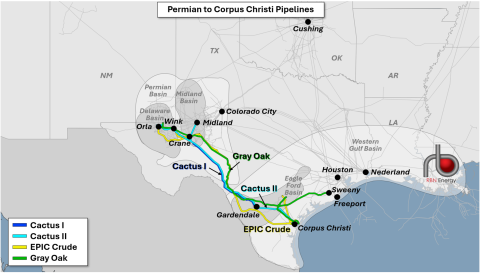The pipelines carrying crude oil from the Permian Basin in West Texas to the Corpus Christi area have been as jammed as an urban highway on the Friday before Memorial Day weekend. The Gray Oak Pipeline, the largest from the Permian to Corpus, has just completed the 80-Mb/d first phase of a planned two-phase expansion that will add a total of 120 Mb/d of capacity. In today’s RBN blog, we’ll discuss what this project means for pipeline congestion and crude exports out of Corpus and nearby Ingleside.
First, let’s offer a quick refresher on the state of the pipelines from the Permian to Corpus Christi. As we’ve frequently discussed in the RBN blogosphere, the Permian Basin has experienced rapid growth in crude oil production and now accounts for 49% of all U.S. output. As shown in Figure 1 below, there are four large pipelines that transport crude oil from the Permian to the Corpus Christi area — Cactus I (blue line), Cactus II (teal line), EPIC Crude (yellow line) and Gray Oak (green line) — which (as of April) collectively provide 2.64 MMb/d of capacity.
Figure 1. Permian-to-Corpus Crude Oil Pipelines. Source: RBN
That brings us to the subject of today’s blog, Gray Oak, an 850-mile crude oil pipeline system that originates from multiple points in West Texas (see Figure 2 below). The pipeline started up with a capacity of 900 Mb/d shortly before crude oil demand cratered as the pandemic hit in 2020. In response to COVID, Permian producers shut in a significant amount of production, but output from the basin quickly rebounded and it didn’t take long for Gray Oak to add volumes — its flows ramped up throughout 2020. Note that it is common for new pipelines to gain volumes from old pipelines as take-or-pay commitments are typical on new pipelines — meaning you pay for the capacity regardless of whether you use it. As discussed in our weekly Crude Oil Permian report, Gray Oak has long operated at high utilization rates, which means nearly every available barrel of capacity is spoken for on what is now a 980-Mb/d pipeline. Its recently completed 80-Mb/d expansion originates at Crane, TX, and flows to Corpus Christi and Ingleside, where it supports crude exports at Enbridge’s Ingleside Energy Center (EIEC; pink square in Figure 2). According to the recently published quarterly edition of our Crude Voyager report, EIEC accounted for just over 30% of total Gulf Coast crude oil exports in Q1 2025 — the highest share among all terminals. It also set daily and quarterly export records.
Join Backstage Pass to Read Full Article









